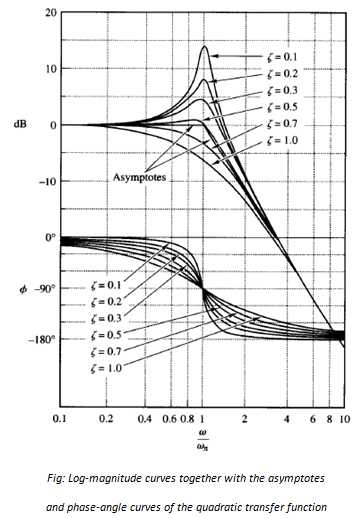Quadratic Factors In Bode Diagram
Quadratic factors in Bode diagram

Control systems often possess quadratic factors of the form

If  this quadratic factor can be expressed as a product of two first-order factors with real poles. If
this quadratic factor can be expressed as a product of two first-order factors with real poles. If  , this quadratic factor is the product of two complex conjugate factors. Asymptotic approximations to the frequency-response curves are not accurate for a factor with low values of
, this quadratic factor is the product of two complex conjugate factors. Asymptotic approximations to the frequency-response curves are not accurate for a factor with low values of  This is because the magnitude and phase of the quadratic factor depend on both the corner frequency and the damping ratio
This is because the magnitude and phase of the quadratic factor depend on both the corner frequency and the damping ratio 
The asymptotic frequency-response curve may be obtained as follows:
Since

for low frequencies such that ω << ωn, the log magnitude becomes

The low-frequency asymptote is thus a horizontal line at 0 dB. For high frequencies such that ω >> ωn, the log magnitude becomes

The equation for the high-frequency asymptote is a straight line having the slope -40 dB/decade since

The high-frequency asymptote intersects the low-frequency one at ω = ωn since at this frequency

This frequency, ωn> is the corner frequency for the quadratic factor considered.
The two asymptotes just derived are independent of the value of  Near the frequency ω = ωn, a resonant peak occurs. The damping ratio
Near the frequency ω = ωn, a resonant peak occurs. The damping ratio  determines the magnitude of this resonant peak. Errors obviously exist in the approximation by straight-line asymptotes. The magnitude of the error depends on the value of
determines the magnitude of this resonant peak. Errors obviously exist in the approximation by straight-line asymptotes. The magnitude of the error depends on the value of  It is large for small values of
It is large for small values of  Figure shows the exact log-magnitude curves together with the straight-line asymptotes and the exact phase-angle curves for the quadratic factor with several values of
Figure shows the exact log-magnitude curves together with the straight-line asymptotes and the exact phase-angle curves for the quadratic factor with several values of  If corrections are desired in the asymptotic curves, the necessary amounts of correction at a sufficient number of frequency points may be obtained from Figure.
If corrections are desired in the asymptotic curves, the necessary amounts of correction at a sufficient number of frequency points may be obtained from Figure.